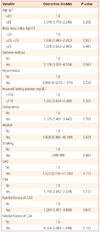This article has been corrected. See "Erratum: Correlation analysis about effect of cardiovascular risk factors and disease in women on overactive bladder and stress urinary incontinence" in Volume 55 on page 899.
Abstract
Objective
The purpose of this study was to investigate associations between overactive bladder / stress urinary incontinence and cardiovascular risk factors and disease.
Methods
We performed a retrospective review of 132 women with overactive bladder and 100 women with stress urinary incontinence, enrolled at Severance Hospital. Risk factors of cardiovascular disease included age, obesity, hypertension, diabetes, impaired fasting glucose, dyslipidemia, cardiovascular disease and familial history of cardiovascular disease.
Results
The two groups had no difference with cardiovascular disease, history of cardiovascular disease, age, obesity, smoking, alcohol, hypertension, dyslipidemia, excluding diabetes. In the univariate logistic regression analysis, diabetes was associated with prevalence of overactive bladder than stress urinary incontinence. In the multiple logistic regression analysis, there was no factor which had influence on the status of urinary incontinence.
Figures and Tables
Table 2
Correlating relationships of cardiovascular disease and cardiovascular risk factors between OAB and SUI

References
1. Abrams P, Cardozo L, Fall M, Griffiths D, Rosier P, Ulmsten U, et al. The standardisation of terminology in lower urinary tract function: report from the standardisation sub-committee of the International Continence Society. Urology. 2003. 61:37–49.
2. Botlero R, Urquhart DM, Davis SR, Bell RJ. Prevalence and incidence of urinary incontinence in women: review of the literature and investigation of methodological issues. Int J Urol. 2008. 15:230–234.
3. Hampel C, Wienhold D, Benken N, Eggersmann C, Thüroff JW. Prevalence and natural history of female incontinence. Eur Urol. 1997. 32:Suppl 2. 3–12.
4. Wagner TH, Hu TW. Economic costs of urinary incontinence. Int Urogynecol J Pelvic Floor Dysfunct. 1998. 9:127–128.
5. Olsen AL, Smith VJ, Bergstrom JO, Colling JC, Clark AL. Epidemiology of surgically managed pelvic organ prolapse and urinary incontinence. Obstet Gynecol. 1997. 89:501–506.
6. Lee KS, Sung HH, Na S, Choo MS. Prevalence of urinary incontinence in Korean women: results of a National Health Interview Survey. World J Urol. 2008. 26:179–185.
7. Sandvik H, Hunskaar S, Vanvik A, Bratt H, Seim A, Hermstad R. Diagnostic classification of female urinary incontinence: an epidemiological survey corrected for validity. J Clin Epidemiol. 1995. 48:339–343.
8. Pearson TA, Blair SN, Daniels SR, Eckel RH, Fair JM, Fortmann SP, et al. American Heart Association Science Advisory and Coordinating Committee. AHA Guidelines for Primary Prevention of Cardiovascular Disease and Stroke: 2002 Update: Consensus Panel Guide to Comprehensive Risk Reduction for Adult Patients Without Coronary or Other Atherosclerotic Vascular Diseases. Circulation. 2002. 106:388–391.
9. Azadzoi KM, Yalla SV, Siroky MB. Oxidative stress and neurodegeneration in the ischemic overactive bladder. J Urol. 2007. 178:710–715.
10. Yoshida M, Masunaga K, Nagata T, Satoji Y, Shiomi M. The effects of chronic hyperlipidemia on bladder function in myocardial infarction-prone Watanabe heritable hyperlipidemic (WHHLMI) rabbits. Neurourol Urodyn. 2010. 29:1350–1354.
11. Choo V. WHO reassesses appropriate body-mass index for Asian populations. Lancet. 2002. 360:235.
12. DeFronzo RA, Abdul-Ghani M. Assessment and treatment of cardiovascular risk in prediabetes: impaired glucose tolerance and impaired fasting glucose. Am J Cardiol. 2011. 108:3 Suppl. 3B–24B.
13. Ryu WS, Lee SH, Kim CK, Kim BJ, Yoon BW. Body mass index, initial neurological severity and long-term mortality in ischemic stroke. Cerebrovasc Dis. 2011. 32:170–176.
14. Sanders JL, Fitzpatrick AL, Boudreau RM, Arnold AM, Aviv A, Kimura M, et al. Leukocyte telomere length is associated with noninvasively measured age-related disease: The Cardiovascular Health Study. J Gerontol A Biol Sci Med Sci. 2012. 67:409–416.
15. Anders K. Recent developments in stress urinary incontinence in women. Nurs Stand. 2009. S:25–27.
16. Daneshgari F, Moore C, Frinjari H, Babineau D. Patient related risk factors for recurrent stress urinary incontinence surgery in women treated at a tertiary care center. J Urol. 2006. 176:1493–1499.
17. McGrother CW, Donaldson MM, Hayward T, Matthews R, Dallosso HM, Hyde C, et al. Urinary storage symptoms and comorbidities: a prospective population cohort study in middle-aged and older women. Age Ageing. 2006. 35:16–24.
18. Waetjen LE, Liao S, Johnson WO, Sampselle CM, Sternfield B, Harlow SD, et al. Factors associated with prevalent and incident urinary incontinence in a cohort of midlife women: a longitudinal analysis of data: study of women's health across the nation. Am J Epidemiol. 2007. 165:309–318.
19. Tunn R, Goldammer K, Neymeyer J, Gauruder-Burmester A, Hamm B, Beyersdorff D. MRI morphology of the levator ani muscle, endopelvic fascia, and urethra in women with stress urinary incontinence. Eur J Obstet Gynecol Reprod Biol. 2006. 126:239–245.
20. Kim JC, Joo KJ, Kim JT, Choi JB, Cho DS, Won YY. Alteration of autonomic function in female urinary incontinence. Int Neurourol J. 2010. 14:232–237.




 PDF
PDF ePub
ePub Citation
Citation Print
Print





 XML Download
XML Download